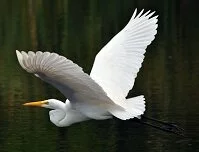Wildlife

Heron (egret)
St. Vincent & the Grenadines has an odd wildlife system as the island nation has few indigenous mammals due to its volcanic origin; nearly all mammals you see on the islands were introduced by people. However, off the island's shore are more mammals and great sea life. In addition to mammals like dolphins and whales, as an island nation there are thousands of fish surrounding the country and these waters contain larger animals like sharks and barracudas, but also include lobsters, angelfish, grouper, sponges, lobsters, snapper, crabs, and thousands more including coral.
Like the sea life, there are plenty of birds that live on the island or migrate through. These birds are mostly limited to water fowls like ducks and herons, but there are other non-water fowl species that call the islands home such as the trembler, hummingbird, and bananaquit. The reptilian and amphibian life is also limited in scope, but there are turtles, snakes, iguanas, and frogs among others. There are numerous other species, including insects.